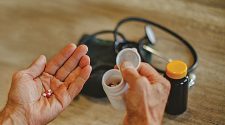Arthritis… A Different Approach
Part 2
In addition to the less conventional therapies, such as the amazing effectiveness of the Indian cooking spice, Turmeric, which we previously discussed in part 1, some remarkable strides forward have been made using stem cells taken from our bodies. This, of course, gets over the problem of our bodies immune systems rejecting the treatment.
As a result of stem cell research, trial therapies have already been carried out by a team of medical researchers, led by Professor Frank Barry, from the National University of Ireland, in the City of Galway. Professor Barry is one of the worlds leading experts on stem cells, and he did this by using patients’ own stem cells, which were obtained by removing a sample of fat from the patient’s own body.
This fat sample then had the stem cells separated out; and, under clinical conditions, the cells were ‘grown’ over a period of time, before being injected back into the patients bodies, in damaged areas of patients’ joints. The results were very encouraging, and resulted in significantly increased joint mobility.
Professor Barry, who was the clinical lead of the studies, said, (Quote)”The results are incredibly exciting, and it’s our strong belief that stem cell treatment will soon offer hope for millions of Arthritis sufferers. He then went on to say, “Statistically, osteoarthritis affects around fifteen percent of people over 25, and more than thirty percent of those people of pensionable age.”
Currently, there is no medical intervention, known drug or therapy, to stop the progression of this disease, and most patients just have to constantly treat themselves with painkillers. Usually, further progression of arthritis will, very often, ultimately result in surgery to replace the damaged joints.
One of the most common forms of Arthritis is Osteoarthritis of the knee, this is probably because our knee-joints usually undergo extreme stresses throughout the course of our everyday lives. Our knees take a pounding due to stresses during a lifetime of walking; or, when twisting and turning if we are playing different sports. Osteoarthritis can affect the main surfaces of your knee-joint and also the cartilage underneath your patella (kneecap). We are most likely to feel pain at the front and sides of our knees.
If you have severe osteoarthritis, your knees may even become bent and bowed, causing you to walk with a limp. Your knee-joint may also become so unstable that it may give way when you put weight on it – this is usually because of muscle weakness in the thigh but sometimes because of damage to the ligaments.
Who is more likely to suffer from osteoarthritis of the knee?
Osteoarthritis of the knee is twice as common in women as it is in men; and, when it happens, it usually affects both knees. It is more likely to cause most problems from our middle to late fifties onwards.
Should I exercise?
Yes, because exercising helps to keep your muscles toned up and your joints supple. You can take gentle exercise without putting too much strain on your joints. Protection of your joints and exercise work together, hand in hand.
Joint protection by gentle exercise reduces strain on you joint capsules and ligaments, which can become slack if you are sedentary: but do remember, straining your joints can make this worse. Regular gentle exercise strengthens all the muscles and ligaments around your joints so that they can give the joints the support they need.
Should I follow a special diet?
Being overweight definitely does put an extra burden on our weight-bearing joints (our back, hips, knees, ankles and feet), which is not good if they’re already damaged or under strain; and, because of the way our joints work, the pressure in our knee joints is five to six times our body weight, when we walk. If only for this reason, it’s important to maintain a healthy weight. You can do this by making sure that you take regular exercise; swimming, for example, is really good for people with arthritis because the buoyancy of the water supports our joints.
Eating a Mediterranean-style diet is good for providing all the nutrients and vitamins we need. This should include:
• Plenty of fruit and vegetables
• Lots of oily fish
• Snacks of nuts and seeds
• Good virgin olive oil.
Some people also take dietary supplements to help protect their joints; for example, glucosamine and chondroitin, which can be found in most health food stores. Generally speaking supplements are relatively well tolerated by our bodies, but you should speak to your doctor about taking them because some can interfere with other medication.
If you do decide to try a supplement, it may be a good idea to keep a written record of what they’re doing for you, and to base your decision on whether or not to continue if you notice whether or not there is any improvement in your condition.
Lifestyle plays a big part in the prevention and treatment of Arthritis; and, because changing our lifetime habits can be very difficult to do, lots of people find it helpful to get together with others who wish to achieve the same results. Good sound advice can be obtained from any hospital occupational therapy department, and they usually also offer joint protection programs where groups of people with arthritis get together to support each other through learning and practicing exercise activities together. This is a great idea, and might be one of the desirable parts of an overall program for people suffering with arthritis.













